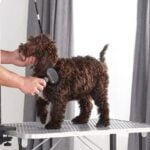Table of Contents
Maintaining a healthy and thriving environment for your Angelfish requires diligent care and attention. Understanding the maintenance of Angelfish tanks is crucial for ensuring your fish live a long and healthy life. In this article, we provide comprehensive tips for the maintenance of Angelfish tanks to help you create the ideal aquarium setting.

Understanding the Basics of Angelfish Tank Maintenance
Proper maintenance of Angelfish tanks starts with understanding the basics of water quality, tank setup, and regular care. Angelfish are sensitive to changes in their environment, so it’s essential to maintain stable conditions. This includes monitoring water parameters, performing regular water changes, and providing a suitable habitat. For more on water quality, visit Aquarium Co-Op.
Choosing the Right Tank Size
The size of your tank plays a significant role in the maintenance of Angelfish tanks. Angelfish require ample space to swim and grow, so a tank size of at least 20 gallons is recommended for a small group. Larger tanks of 30 gallons or more are ideal for accommodating more fish and providing a stable environment. For more information, see our guide on Choosing the Right Tank Size for Angelfish.
Water Quality and Filtration
Maintaining optimal water quality is critical for the health of your Angelfish. Use a high-quality filter to keep the water clean and clear. Regularly test the water for ammonia, nitrite, nitrate, and pH levels. Aim to keep ammonia and nitrite levels at 0 ppm, nitrate levels below 20 ppm, and pH between 6.5 and 7.5. Learn more about water testing at Fishkeeping World.
Performing Regular Water Changes
Regular water changes are essential for the maintenance of Angelfish tanks. Perform a 20-30% water change every week to remove accumulated waste and toxins. Use a gravel vacuum to clean the substrate and remove debris during water changes. Always use dechlorinated water that matches the temperature of the tank water. For detailed steps, check our Water Change Guide.
Temperature and Heating
Angelfish thrive in warm water temperatures between 75°F and 82°F. Use a reliable aquarium heater to maintain a consistent temperature. Monitor the temperature regularly with a thermometer to ensure it stays within the ideal range. Sudden temperature fluctuations can stress your Angelfish and lead to health issues. For more on aquarium heating, visit LiveAquaria.
Providing Proper Lighting
Proper lighting is important for the overall health of your aquarium and its inhabitants. Angelfish prefer moderate lighting that mimics their natural environment. Use an aquarium light with a timer to provide a consistent light cycle of 8-10 hours per day. Avoid excessive lighting, which can promote algae growth. For lighting options, see our Aquarium Lighting Tips.
Feeding Your Angelfish
Feeding is a crucial aspect of the maintenance of Angelfish tanks. Provide a balanced diet that includes high-quality flake or pellet food, supplemented with live or frozen foods such as brine shrimp, bloodworms, and daphnia. Feed your Angelfish 2-3 times a day, offering only as much as they can consume in a few minutes to prevent overfeeding and water pollution. For more on feeding, visit Seriously Fish.
Decorations and Hiding Places
Creating a stimulating environment with decorations and hiding places is beneficial for your Angelfish. Use plants, rocks, and driftwood to create a natural habitat. These elements provide hiding spots and reduce stress for your fish. Ensure all decorations are aquarium-safe and do not have sharp edges that could harm your Angelfish. For decoration ideas, check our Aquarium Decoration Guide.
Monitoring and Controlling Algae Growth
Algae growth is a common issue in aquariums. Control algae by maintaining proper lighting, performing regular water changes, and using an algae scraper to clean the tank walls. Introducing algae-eating fish or snails can also help keep algae under control. Avoid overfeeding, as excess food can contribute to algae growth. For more tips, visit Aqueon.
Observing Your Angelfish for Signs of Stress or Illness
Regular observation is key to maintaining a healthy Angelfish tank. Watch for signs of stress or illness, such as changes in behavior, loss of appetite, discoloration, or unusual spots. Early detection of problems allows for timely intervention and treatment. Quarantine new fish before introducing them to the main tank to prevent the spread of diseases. For more on fish health, visit Fish Channel.
Conclusion
Proper maintenance of Angelfish tanks involves regular monitoring, cleaning, and care. By understanding and implementing these essential tips, you can create a healthy and thriving environment for your Angelfish. Consistent care ensures your fish remain happy and vibrant, enhancing the beauty of your aquarium.
FAQs
How often should I clean my Angelfish tank?
Perform a 20-30% water change every week and use a gravel vacuum to clean the substrate. Regular cleaning helps maintain water quality and removes waste.
What is the ideal temperature for Angelfish tanks?
The ideal temperature for Angelfish tanks is between 75°F and 82°F. Use a reliable aquarium heater and monitor the temperature regularly to maintain consistency.
How can I prevent algae growth in my Angelfish tank?
Prevent algae growth by maintaining proper lighting, performing regular water changes, and using an algae scraper. Introducing algae-eating fish or snails can also help control algae.
What should I feed my Angelfish?
Provide a balanced diet of high-quality flake or pellet food, supplemented with live or frozen foods like brine shrimp, bloodworms, and daphnia. Feed 2-3 times a day, offering only as much as they can consume in a few minutes.
How do I know if my Angelfish are stressed or ill?
Signs of stress or illness include changes in behavior, loss of appetite, discoloration, or unusual spots. Regular observation and early detection allow for timely intervention and treatment.
How big should my Angelfish tank be?
A tank size of at least 20 gallons is recommended for a small group of Angelfish. Larger tanks of 30 gallons or more are ideal for accommodating more fish and providing a stable environment.











